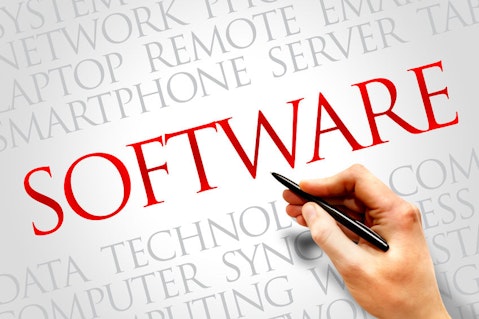HashiCorp, Inc. (NASDAQ:HCP) Q2 2024 Earnings Call Transcript August 31, 2023
HashiCorp, Inc. beats earnings expectations. Reported EPS is $0.1, expectations were $-0.15.
Operator: Ladies and gentlemen, thank you for standing by, and welcome to HashiCorp’s Fiscal 2024 Second Quarter Earnings. At this time, all participants are in a listen-only mode. After the speakers’ presentation, there will be a question-and-answer session. [Operator Instructions] Please be advised that today’s conference is being recorded. I would now like to turn the conference over to your first speaker today to Alex Kurtz, VP of Investor Relations and Corporate Development. Thank you. Please go ahead.
Alex Kurtz: Good afternoon, and welcome to HashiCorp’s fiscal 2024 second quarter earnings call. This afternoon, we will be discussing our second quarter fiscal 2024 financial results announced in our press release issued after the market closed today. With me are HashiCorp’s CEO, Dave McJannet; CFO; Navam Welihinda; and CTO and Co-Founder, Armon Dadgar. In conjunction with our earnings press release, we have published an earnings presentation that provides additional information about our quarter. We encourage you to review that presentation in advance of our call. You can access it on our investor website at ir.hashicorp.com. Today’s call will contain forward-looking statements, which are made under the safe harbor provisions of the Private Securities Litigation Reform Act of 1995.
Forward-looking statements include statements concerning financial and business trends, our expected future business and financial performance and financial condition and our guidance for the third quarter and full 2024 fiscal year. These statements may be identified by words such as expect, anticipate, intend, plan, believe, seek or will or similar statements. These statements reflect our views as of today only and should not be relied upon as representing our views at any subsequent date, and we do not undertake any duty to update these statements. Forward-looking statements by their nature address matters that are subject to risks and uncertainties that could cause actual results to differ materially from expectations. During the call, we will also discuss certain non-GAAP financial measures, which are not prepared in accordance with generally accepted accounting principles.
The financial measures presented on this call are prepared in accordance with GAAP unless otherwise noted. A reconciliation of these non-GAAP financial measures to the most directly comparable GAAP financial measures as well as how we define these and other metrics is included in our earnings press release, which has been furnished to the SEC and is also available on our website at ir.hashicorp.com. Finally, we will be holding an investor event during our annual HashiCorp User Conference in San Francisco on October 11th. We look forward to seeing many of you there, and we will also live stream the event from our IR site. With that, let me turn the call over to Dave. Dave?
Dave McJannet: Thank you, Alex, and welcome everyone to our second quarter earnings call for fiscal 2024. We reported solid second quarter results that exceeded our top and bottom line guidance with revenue of $143 million, representing year-over-year growth of 26%. Current non-GAAP remaining performance obligations reached $420 million, representing 30% year-over-year growth and we added 21 customers with greater than or equal to $100,000 in annual recurring revenue to reach a total of 851. Our HashiCorp Cloud Platform offerings reached $18.4 million in revenue, representing 13% of subscription revenue in the quarter. We’re excited for the new capabilities we announced during HashiDays in Europe around HCP and Terraform, Vault, Boundary and across our whole product portfolio, and we have more to announce at our Global User Conference this October.
Our team executed well and delivered solid results against an ongoing challenging backdrop. Although we continue to see elongated deal cycles, our performance shows that we remain a critical part of the Global 2000’s cloud plans and our strategic partner for their long-term transitions to the cloud. To put it simply, though the purchasing environment is difficult, we continue to win the market. As an example of this, in June, we hosted our European User Conference taking place in the three sold out locations simultaneously, in Paris, Munich and in London. During the keynote, I was joined by a large multinational financial services company, who is a long-time HashiCorp customer and an excellent example of how over time we’ve become a strategic partner to the Global 2000.

Copyright: dizanna / 123RF Stock Photo
This customer shared how they approach their move to the cloud and how they adopted a platform engineering team to scale their consumption of cloud resources using automated provisioning from Terraform Enterprise. As their platform team expanded their use of Terraform, they enabled more than 3,000 developers to consume cloud resources autonomously and powered over 200 internal applications, which ultimately accelerated delivery of new capabilities for their banking customers. This customer use case is a great example of the long-term journey their organizations make with us. At HashiDays, we also made several product announcements that highlighted continued investment in innovation across our portfolio, and I want to briefly share a few of those.
First, we announced the highly anticipated general availability of HashiCorp Boundary Enterprise. The early response to Boundary Enterprise has been exciting, with a healthy initial pipeline and interest growing by the day. As organizations transition to cloud, they are finding they require a modern cloud-friendly privileged access management solution, which until Boundary was not available in the market. We also announced several product enhancements across our portfolio, including Terraform, Vault and Consul. This quarter, as I traveled and met with customers in Europe and other parts of the world, I heard a consistent message from them. The transition to the cloud is still in full swing and requires new approaches to managing infrastructure, which our products provide.
And once these new approaches and technologies are adopted, teams are enabled to build faster, more efficiently and more securely. Despite macroeconomic conditions, customer planning for cloud hasn’t changed. Finally, I want to reiterate that we remain focused on achieving our profitability targets while at the same time positioning ourselves for a future of continued cloud adoption. I remain very optimistic about our long-term opportunity, and we continue to build HashiCorp to meet it. Thank you. I look forward to seeing you at our investor event during HashiConf in San Francisco in October. Now, I’d like to turn it over to Navam and I look forward to answering any questions.
Navam Welihinda: Thank you, Dave, and thanks again to everyone for joining us today. As Dave mentioned, we are pleased with our team’s performance for the second quarter and delivered solid top line results. Compared to our seasonally low first quarter, we saw better contract activity both in total and also within the Global Enterprise segment during the second quarter. Similar to last quarter, sales cycles remain elongated, and procurement scrutiny was ongoing. We expect this cautious spending environment to persist through the rest of 2024. However, we also expect the bigger trend of enterprise cloud transformation efforts to continue despite the current economic uncertainty. On the expense side, we continue to operate the business with a heavy focus on ROI, resulting in better than forecasted non-GAAP EPS for the quarter.
As a reminder, the second quarter for HashiCorp is a seasonally low free cash flow and cash flow from operations quarter, mainly due to the seasonal first quarter contract volume where collections occur in the second quarter. Free cash flow reverts back to normal trends in Q3 and Q4, and we always view free cash flow and cash flow from operations on a trailing four-quarter basis. Our full guidance numbers can be found in our earnings presentation available on our ir.hashicorp.com website under Financials, Quarterly Results. I encourage you to read through the doc for full metric disclosures, share count disclosures and GAAP to non-GAAP reconciliations. To summarize our guidance, for the third quarter of fiscal ’24, we expect total revenue in the range of $142 million to $144 million.
and a non-GAAP operating loss in the range of $26 million to $23 million. For the full fiscal year ’24 we expect total revenue in the range of $571 million and $575 million and expect FY24 non-GAAP operating loss in the range of $108 million and $105 million. A couple of final notes before Q&A. First, the severance costs from the reduction in force from last quarter was included in our non-GAAP expenses. These costs amounted to $7 million or an additional $0.04 in non-GAAP EPS. And second, as a reminder, our third quarter has typical seasonality due to the summer months, and we have factored the seasonality into our guidance. In closing, we are excited to see many of you at our investor event on October 11th that will also be live streamed on our IR site.
Thanks for your attention. Dave, Armon and I are available to take any of your questions. Alex?
Alex Kurtz: Thank you. Operator, can we go to our first question?
See also 25 Countries With The Most TikTok Users 2023 and 10 Best Uninterrupted Power Supplies in 2023.
Q&A Session
Follow Hashicorp Inc.
Follow Hashicorp Inc.
Operator: Thank you. [Operator Instructions] And I show our first question comes from the line of Ittai Kidron from Oppenheimer. Please go ahead.
Ittai Kidron: Thanks guys. Shortened to the point I like it. Maybe you can talk about productivity and this quarter on the sales force side, how do you feel about progression there? And maybe, I know it’s early, but anything you can share about Susan’s first days in the field, any noticeable thoughts perhaps on how she’s doing and what she’s planning?
Dave McJannet: Hey Ittai. Thanks for the question. It’s Dave. On to the Susan question, just to remind folks that Susan understands the Company well through her time on the Board and is certainly already adding value. She’s been spending her time with the field teams, understands the lay of the land. And I would say that there’s a lot of excitement for her leadership. It’s super, super early for her involvement with us. The question around sort of progression and productivity, I think perhaps it’s more of a broader question around sort of the demand environment and how we’re seeing it. And I would say that — I would say, I did like 20 meetings this week with companies who were in town for the Google Next event. And I’m reminded of the critical role that we play in the infrastructure life cycle is pretty profound for the largest companies in the world.
And that being said, we’re in the midst of an optimization cycle, I think in the software market in general, and there’s a lot of conservatism on spend, and we certainly have reflected that in our approach. But that being said, we don’t see any material change in people’s cloud plans or the competitive dynamics of the market. And we’re just focused on winning the trust of the largest organizations in the world.
Operator: And I show our next question comes from the line of Alex Zukin from Wolfe Research. Please go ahead.
Alex Zukin: I guess maybe just first one for you, Dave, like you mentioned the environment is kind of unchanged. I guess, did it change between kind of the beginning and the end of the quarter and here into the following quarter, has it gotten any better or worse? And then, bigger picture, do you see changing spend priorities, meaning generative coming in and almost crowding out some other projects, pushing out some other initiatives on a longer time scale? And then just one for Navam, if the recent BSL change, how should we be thinking about any numerical or model impacts from that over the course of the next few quarters?
Dave McJannet: I’ll try to tackle those in order and I’ll let maybe Armon to answer a couple of them. On the question on the demand environment, no, since in the last couple of months, honestly, it feels pretty consistent. As we’ve always been clear to communicate, our products are deeply considered because they’re very, very seriously parts of the infrastructure stack. And so, the front-end demand signals remain super consistent that — how that flows through procurement is we find out later. So I would say net not a huge change. On the spend priorities, I would actually just point back to people need to keep in mind that this AI push implies cloud. New applications that are AI in their orientation are built on cloud infrastructure.
And in as much as that is the truth, our products play a role. So, I would say, actually, our products underpin much of what’s happening under the covers in the cloud estates. And so, we are part of that strategic initiative generally speaking. So, that’s probably the best way to describe it. Any other comment you’d make Armon about it?




